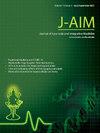瑜伽对临床人群肺功能的影响:随机对照试验(rct)的系统回顾和荟萃分析
IF 1.9
Q3 INTEGRATIVE & COMPLEMENTARY MEDICINE
引用次数: 0
摘要
本研究旨在探讨瑜伽练习对临床人群肺和呼吸功能的影响。在Cochrane图书馆、PubMed、Science Direct数据库和谷歌Scholar中进行了彻底的搜索,使用关键词“yoga *”和“肺功能”,涵盖了2010年1月至2022年12月的时间。纳入了符合PRISMA建议的研究。采用Cochrane风险评估工具评估偏倚风险。我们以95%置信区间(ci)计算加权平均差异(wmd),并使用I2检验评估异质性。最初,通过搜索发现了529项研究,其中10项随机对照试验(rct)涉及1007名患者,符合质量评估和荟萃分析的纳入标准。结果表明,与对照组相比,瑜伽干预(YI)显著改善了FVC% (WMD: 3.03 L, 95% CI: 1.71, 4.35, P < 0.00001)、FEV1 (WMD: 0.47 L, 95% CI: 0.43, 0.51, P < 0.00001)和FEV1% (WMD: 5.74 L, 95% CI: 4.47, 7.01, P < 0.00001)。但对植被覆盖度无显著影响(WMD: 0.23 L, CI: 0.16, 0.62)。P = 0.25),病人(CI大规模杀伤性武器:0.49:0.70,1.67,P = 0.42), MVV (CI大规模杀伤性武器:9.01:3.92,21.94,P = 0.17),和FEV1 / FVC的(大规模杀伤性武器:3.17,CI: 1.15, 7.48, P = 0.15)由于易建联。基于有限的证据和荟萃分析,在临床人群中,YI显示出对肺功能的积极作用,可以考虑作为各种呼吸系统疾病患者的辅助治疗。为了证实瑜伽的长期益处,有必要进行更大规模的严格研究。本文章由计算机程序翻译,如有差异,请以英文原文为准。
Impact of yoga on pulmonary functions in clinical population: A systematic review and meta-analysis of randomized controlled trials (RCTs)
This study aims to investigate the impact of yoga practice on pulmonary and respiratory functions in clinical populations. A thorough search was carried out in the Cochrane Library, PubMed, Science Direct databases, and Google Scholar, using the keywords “Yog∗” and “pulmonary functions”, covering the period from January 2010 to December 2022. Studies that aligned with PRISMA recommendations were included. The Cochrane risk-assessment tool was employed to assess bias risk. We calculated weighted mean differences (WMDs) with 95 % confidence intervals (CIs) and used the I2 test to assess heterogeneity. Initially, 529 studies were found through the search, with 10 randomized controlled trials (RCTs) involving 1007 patients meeting the inclusion criteria for quality assessment and meta-analysis. The results indicated that yoga intervention (YI) significantly improved FVC% (WMD: 3.03 L, 95 % CI: 1.71, 4.35, P < 0.00001), FEV1 (WMD: 0.47 L, 95 % CI: 0.43, 0.51, P < 0.00001), and FEV1% (WMD: 5.74 L, 95 % CI: 4.47, 7.01, P < 0.00001) when compared to control groups. However, no significant effect was observed on FVC (WMD: 0.23 L, CI: 0.16, 0.62. P = 0.25), PEFR (WMD: 0.49, CI: 0.70, 1.67, P = 0.42), MVV (WMD: 9.01, CI: 3.92, 21.94, P = 0.17), and FEV1/FVC (WMD: 3.17, CI: 1.15, 7.48, P = 0.15) as a result of YI. Based on the limited evidence and meta-analysis conducted, YI demonstrated a positive effect on pulmonary function in clinical populations and could be considered as an adjunct therapy for individuals with various respiratory diseases. Further rigorous research with larger sample sizes is necessary to confirm the long-term benefits of yoga.
求助全文
通过发布文献求助,成功后即可免费获取论文全文。
去求助
来源期刊

Journal of Ayurveda and Integrative Medicine
INTEGRATIVE & COMPLEMENTARY MEDICINE-
CiteScore
4.70
自引率
12.50%
发文量
136
审稿时长
30 weeks
 求助内容:
求助内容: 应助结果提醒方式:
应助结果提醒方式:


